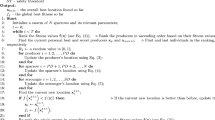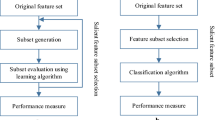Abstract
Swarm intelligence algorithms can efficiently solve feature selection optimization problems for classification, and their classification performance is also excellent. The Sparrow Search Algorithm (SSA) has recently become a novel optimization method, which has the advantages of fewer parameters, a simple structure, and ease of implementation. Unfortunately, the traditional SSA has certain difficulties, trapping into a local optimum easily, and has a weakness in convergence. In this work, a novel SSA is studied to further develop two types of binary SSA for feature selection (BSSFS) to address optimization problems. First, to make the initial population of sparrows distributed as evenly as possible in the search space and augment the diversity of sparrows, a cubic chaotic mapping scheme needs to be introduced to initialize the sparrow population, and a reverse learning scheme is employed to enhance the global search ability of SSA. Second, the nonlinear adaptive inertia weight and the improved control parameters of step size are used to modify the position update formula of the sparrows and avert trapping into a local optimum. By integrating these strategies, a novel SSA (NSSA in short) is designed in this work. Third, NSSA is combined with the S- and V-shaped transfer functions, and the fitness function, which is raised on account of the set size of selected features and the classification error rate, are employed to design two types of BSSFS with the S- and V-shaped transfer functions, shortened as FSBSS and FSBSV, respectively. Finally, the optimization results for 18 classical benchmark functions illustrate that the optimization effectiveness of the NSSA is superior to that of other methods, and the experimental results on 10 low-dimensional and 10 high-dimensional datasets demonstrate that the FSBSV can outdo other comparative algorithms in terms of the classification effectiveness and robustness.









Similar content being viewed by others
Data availability
All data used in this paper is publicly available and can be found in the cited paper.
References
Hussien AG, Amin M (2022) A self-adaptive Harris Hawks optimization algorithm with opposition-based learning and chaotic local search strategy for global optimization and feature selection. Int J Mach Learn Cybern 13:309–336
Sun L, Wang LY, Ding WP, Qian YH, Xu JC (2021) Feature selection using fuzzy neighborhood entropy-based uncertainty measures for fuzzy neighborhood multigranulation rough sets. IEEE Trans Fuzzy Syst 29(1):19–33
Dokeroglu T, Deniz A, Kiziloz HE (2022) A comprehensive survey on recent metaheuristics for feature selection. Neurocomputing 494:269–296
Lin YJ, Hu QH, Liu JH, Duan J (2015) Multi-label feature selection based on max-dependency and min-redundancy. Neurocomputing 168(30):92–103
Sun L, Wang TX, Ding WP, Xu JC, Lin YJ (2021) Feature selection using fisher score and multilabel neighborhood rough sets for multilabel classification. Inf Sci 578:887–912
Tawhid MA, Ibrahim AM (2020) Feature selection based on rough set approach, wrapper approach, and binary whale optimization algorithm. Int J Mach Learn Cybern 11:573–602
Li JD, Cheng KW, Wang SH, Morstatter F, Trevino RP, Tang JL, Liu H (2017) Feature selection: a data perspective. ACM Comput Surv (CSUR) 50(6):1–45
Sun L, Wang XY, Ding WP, Xu JC, Meng HL (2023) TSFNFS: two-stage-fuzzy-neighborhood feature selection with binary whale optimization algorithm. Int J Mach Learn Cybern 14:609–631
Ma XA, Ju CH (2022) Fuzzy information-theoretic feature selection via relevance, redundancy, and complementarity criteria. Inf Sci 611:564–590
Wang XJ, Yan YX, Ma XY (2020) Feature selection method based on differential correlation information entropy. Neural Process Lett 52:1339–1358
Zhang R, Zhang ZQ (2020) Feature selection with symmetrical complementary coefficient for quantifying feature interactions. Appl Intell 50:101–118
Xue B, Zhang MJ, Browne WN, Yao X (2015) A survey on evolutionary computation approaches to feature selection. IEEE Trans Evol Comput 20(4):606–626
Sun L, Si SS, Zhao J, Xu JC, Lin YJ, Lv ZY (2023) Feature selection using binary monarch butterfly optimization. Appl Intell 53:706–727
Boussaid I, Lepagnot J, Siarry P (2013) A survey on optimization metaheuristics. Inf Sci 237:82–117
Hussain K, Salleh MNM, Cheng S, Shi HY (2019) Metaheuristic research: a comprehensive survey. Artif Intell Rev 52:2191–2233
Dokeroglu T, Sevinc E, Kucukyilmaz T, Cosar A (2019) A survey on new generation metaheuristic algorithms. Comput Ind Eng 137:106040
Ghanem WAHM, Jantan A (2018) Hybridizing artificial bee colony with monarch butterfly optimization for numerical optimization problems. Neural Comput Appl 30(1):163–181
Isuwa J, Abdullahi M, Sahabi Ali Y, Abdulrahim A (2022) Hybrid particle swarm optimization with sequential one point flipping algorithm for feature selection. Computat Pract Exper 34(25):e7239
Wang J, Lin DK, Zhang YZ, Huang SG (2022) An adaptive balanced grey wolf optimization algorithm for feature selection on high-dimensional classification. Eng Appl Artif Intell 114:105088
El-Hasnony IM, Elhoseny M, Tarek Z (2022) A hybrid feature selection model based on butterfly optimization algorithm: COVID-19 as a case study. Expert Syst 39(3):e12786
Sun L, Wang XY, Ding WP, Xu JC (2022) TSFNFR: two-stage fuzzy neighborhood-based feature selection with binary whale optimization algorithm for imbalanced data classification. Knowl-Based Syst 256:109849
Ewees AA, Ismail Fatma H, Sahlol Ahmed T (2023) Gradient-based optimizer improved by smile mould algorithm for global optimization and feature selection for diverse computation problems. Expert Syst Appl 213:118872
Sayed GI, Khoriba G, Haggag MH (2022) A novel chaotic equilibrium optimizer algorithm with S-shaped and V-shaped transfer functions for feature selection. J Ambient Intell Humaniz Comput 13:3137–3162
Fridausanti NA, Irhamah (2019) On the comparison of crazy particle swarm optimization and advanced binary ant colony optimization for feature selection on high-dimensional data. Procedia Comput Sci 161:638–646
Li AD, Xue B, Zhang MG (2021) Improved binary particle swarm optimization for feature selection with new initialization and search space reduction strategies. Appl Soft Comput 106:107302
Moldovan D (2022) Binary horse optimization algorithm for feature selection. Algorithm 15(5):156
Xue JK, Shen B (2021) A novel swarm intelligence optimization approach: sparrow search algorithm. Syst Sci Control Eng 8:22–34
Ouyang CT, Liu YJ, Zhu DL (2021) An adaptive chaotic sparrow search algorithm. IEEE 2nd international conference on big data, artificial intelligence and internet of things engineering (ICBAIE). Nanchang, China, pp 76–82
Tang AD, Zhou H, Han T, Xie L (2022) A chaos sparrow search algorithm with logarithmic spiral and adaptive step for engineering problems. CMES-Comput Model Eng Sci 130(1):331–364
Fathy A, Alanazi TM, Rezk H, Yousri D (2022) Optimal energy management of micro-grid using sparrow search algorithm. Energy Rep 8:758–773
Zhang CL, Ding SF (2021) A stochastic configuration network based on chaotic sparrow search algorithm. Knowl-Based Syst 220:106924
Chen HW, Ma X, Huang S (2021) A feature selection method for intrusion detection based on parallel sparrow search algorithm. IEEE 16th international conference on computer science & education (ICCSE). Lancaster, United Kingdom, pp 685–690
Zohre S, Ebrahim A, Hossein N (2021) A hybrid feature selection method based on information theory and binary butterfly optimization algorithm. Eng Appl Artif Intell 97:104079
Chaudhuri A, Sahu TP (2022) Binary java algorithm based on similarity measure for feature selection. J Ambient Intell Humaniz Comput 13:5627–5644
Sharafi Y, Teshnehlab M (2021) Opposition-based binary competitive optimization algorithm using time-varying V-shaped transfer function for feature selection. Neural Comput Appl 33:17495–17533
Al-Betar MA, Hammouri AI, Awadallah MA, Doush LA (2021) Binary β-hill climbing optimizer with S-shaped transfer function. J Ambient Intell Humaniz Comput 12:7637–7665
Thaher T, Chantar H, Too JW, Mafarja M, Turabieh H (2022) Boolean particle swarm optimization with various evolutionary population dynamics approaches for feature selection problems. Expert Syst Appl 195:116550
Wang Y, Zhang X, Yu DJ, Bai YJ, Du JP, Tian ZY (2022) Tent chaotic map population classification evolution strategy-based dragonfly algorithm for global optimization. Math Probl Eng 2022:2508414
Zhang MH, Zhang H, Chen X, Yang J (2021) Grey wolf optimization algorithm based on Cubic mapping and its application. Chin Comput Sci Technol 43(11):2035–2042
Feng JH, Zhang J, Zhu XS, Lian WW (2021) A novel chaos optimization algorithm. Multimed Tools Appl 76:17405–17436
Herdianti W, Gunawan AAS, Komsiyah S (2021) Distribution cost optimization using pigeon inspired optimization method with reverse learning mechanism. ScienceDirect 179:920–929
He XL, Zhang G, Chen YH, Yang SZ (2021) Multi-class algorithm of WOA-SVM using Levy flight and elite opposition-based learning. Chin Comput Appl Res 35(12):3640–3645
Zheng HQ, Feng WJ, Zhou YQ (2022) Butterfly optimization algorithm based on sine cosine algorithm. Chin Guangxi Sci 28(2):152–159
Liang QK, Chen B, Wu HN, Ma CY, Li SY (2021) A novel modified sparrow search algorithm with the application in side lobe level reduction of linear antenna array. Wirel Commun Mob Comput. https://doi.org/10.1155/2021/9915420
Agrawal A, Tripathi S (2021) Particle swarm optimization with adaptive inertia weight based on cumulative binomial probability. Evol Intel 14:305–313
Sun L, Yin TY, Ding WP, Qian YH, Xu JC (2022) Feature selection with missing labels using multilabel fuzzy neighborhood rough sets and maximum relevance minimum redundancy. IEEE Trans Fuzzy Syst 30(5):1197–1211
Faris H, Mafarja MM, Heidari AA, Ibrahim A, AlZoubi AM, Seyedali M, Hamido F (2018) An efficient binary slap swarm algorithm with crossover scheme for feature selection problems. Knowl-Based Syst 154:43–67
Ji B, Lu XZ, Sun G, Zhang W, Li JH, Xiao YZ (2020) Bio-inspired feature selection: an improved binary particle swarm optimization approach. IEEE Access 8:85989–86002
Mirjalili S, Lewis A (2013) S-shaped versus V-shaped transfer function for binary particle swarm optimization. Swarm Evol Comput 9:1–14
Kennedy J, Eberhart RC (1997) A discrete binary version of the particle swarm algorithm, IEEE international conference on systems, man, and cybernetics. Comput Cybern Simul 5:4104–4108
Rashedi E, Nezamabadi-pour H, Saryazdi S (2010) BGSA: binary gravitational search algorithm. Nat Comput 9(3):727–745
Mafarja M, Aljarah I, Faris H, Hammouri A, AlZoubi AM (2019) Binary grasshopper optimization algorithm approaches for feature selection problems. Expert Syst Appl 117:267–286
Zhao WZ, Wang LY, Zhang ZX (2019) Atom search optimization and its application to solve a hydrogeologic parameter estimation problem. Knowl-Based Syst 163:283–304
Sun L, Zhao J, Xue ZA (2022) Feature selection method based on improved monarch butterfly optimization algorithm. Chin Pattern Recognit Artif Intell 39(2):981–994
Zhang YY, Jin ZG, Mirjalili S (2020) Generalized normal distribution optimization and its applications in parameter extraction of photovoltaic models. Energy Convers Manag 227:113301
Yapici H, Cetinkaya N (2019) A new meta-heuristic optimizer: pathfinder algorithm. Appl Soft Comput J 78:545–568
Milad S, Abdolreza R, Sadegh F (2021) Particle distance rank feature selection by particle swarm optimization. Expert Syst Appl 185(15):115620
Sun L, Wang TX, Ding WP, Xu JC (2022) Partial multilabel learning using fuzzy neighbourhood-based ball clustering and kernel extreme learning machine. IEEE Trans Fuzzy Syst. https://doi.org/10.1109/TFUZZ.2022.3222941
Sun L, Zhang XY, Qian YH, Xu JC, Zhang SG (2019) Feature selection using neighbourhood entropy-based uncertainty measures for gene expression data classification. Inf Sci 502:18–41
Acknowledgements
The authors would like to express their sincere appreciation to the anonymous reviewers for their insightful comments, which greatly improved the quality of this paper. This research was funded by the National Natural Science Foundation of China under Grants 62076089, 61976082, and 61976120; the Excellent Science and Technology Innovation Team of Henan Normal University under Grant 2021TD05; and the Natural Science Key Foundation of Jiangsu Education Department under Grant 21KJA510004.
Author information
Authors and Affiliations
Corresponding authors
Additional information
Publisher's Note
Springer Nature remains neutral with regard to jurisdictional claims in published maps and institutional affiliations.
Rights and permissions
Springer Nature or its licensor (e.g. a society or other partner) holds exclusive rights to this article under a publishing agreement with the author(s) or other rightsholder(s); author self-archiving of the accepted manuscript version of this article is solely governed by the terms of such publishing agreement and applicable law.
About this article
Cite this article
Sun, L., Si, S., Ding, W. et al. BSSFS: binary sparrow search algorithm for feature selection. Int. J. Mach. Learn. & Cyber. 14, 2633–2657 (2023). https://doi.org/10.1007/s13042-023-01788-8
Received:
Accepted:
Published:
Issue Date:
DOI: https://doi.org/10.1007/s13042-023-01788-8




